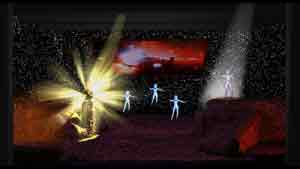
Overture

Scene 1a

Scene 1b

Scene 2a

Scene 3a

Scene 4a

Scene 4b
Das Rheingold
| Richard Wagner's opera, Das Rheingold, is a product of the German nationalistic spirit of its time. Its story is an ancient, epic story. The struggle between power and love is a timeless one. When Wagner chose this story from Teutonic mythology he connected with a history that was common to all the Germanic peoples. While the story itself is filled with conflict, Wagner's objective was unity. Unity of his audience, his countrymen. By experiencing a shared history, the peoples of Germany find cause to consider themselves one people. Unification of the German people is not a concern of today's audiences. Diversity is the buzzword of today's culture. In this country people go to great lengths to showcase their cultural heritage. Of particular interest is anything that can set oneself apart from the Anglo mainstream. So, why do Das Rheingold? The key lies in the popular idea of "one people, one race". This concept is that while people come from diverse cultures, we are all unified by our common humanity. That is the starting point for this design. This design takes Wagner's story beyond German nationalism to serve a different, larger goal. The Rhine has become the vast ether of the cosmos. The setting is not our world, but is composed of the stardust that will later form man and the Earth. The idea of the universe beginning with a void or ether is common to many mythologies, sciences and spiritual systems. Therefore, despite our different colors and creeds, we are all products of the same primordial soup. This basis propels us toward a larger unity, a unity of mankind. |
Storyboard
 Overture |
The Overture - The stage is dark except for a large LED video screen and a field of stars. The video is a montage celestial bodies forming in the primordial soup. Astronomy buffs will recognize the Horsehead Nebula in this rendering. |
 Scene 1a |
Scene One - The video screen pivots upstage. Behind it are the three Rheinmaidens, caretakers of the Rheingold. They walk down the star covered upstage ramp. They can move freely between the ramp, which is the sky, and the surface below. Their costumes are built with small lights so they are self-luminous. They serve as walking constellations from the heavens (the Rhein.) The stage has a moon-like texture. Later in the scene Albrecht emerges from a trap in the floor. Albrecht is a Nibelung, a dwarf, from beneath the surface. |
 Scene 1b |
Later in scene one the Rheingold appears. A shaft of golden light strikes the surface and the Rheingold rises up upon a rock pedestal. It is a spectacle of fog and blinding light. The scene ends with Albrecht stealing the Rheingold and taking it to the underworld. |
 Scene 2a |
Scene Two - During the scene change the video screen pivots back to vertical. Two stone colonnades fly in and a giant stone pillar rolls on. They have raised and recessed panels carved into them. This place is the home of Wotan, king of the gods. A new castle in the sky has been built for him. It is carved from an asteroid and can be seen in the distance on the video screen. In scene two, Wotan decides that he must have the Rheingold. He goes to the underworld to take it from Albrecht, who has used its power to enslave the dwarves below. |
 Scene 3a |
Scene Three - This scene takes place beneath the surface. The rectangular video display flies out and an oval one flies in. During the "anvil chorus" the display shows a star field getting smaller and smaller, as the point of view descends down a chasm. The upstage star field is replaced with a black void and the colonnades are replaced by giant menhirs. Here, Wotan steals the Rheingold from Albrecht and returns to the surface. |
 Scene 4a |
Scene Four - We are back at Wotan's place on the surface. In this image Erda, the god of the Earth, speaks to Wotan. Erda is represented by an intense wash of white light and a voice singing from the orchestra pit. |
 Scene 4b |
This image is the opera's finale. The castle Valhalla is drawn closer on a conduit of rainbow light. |